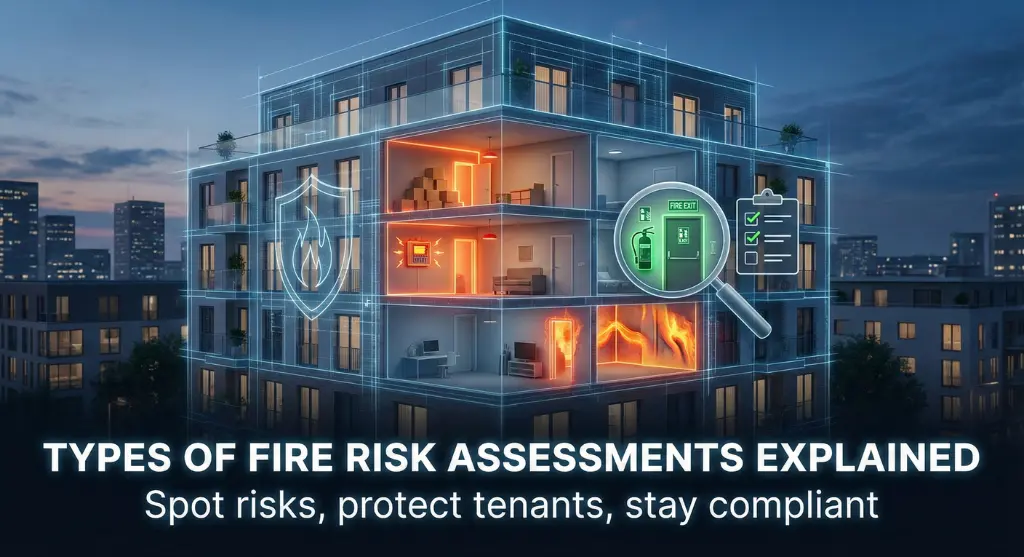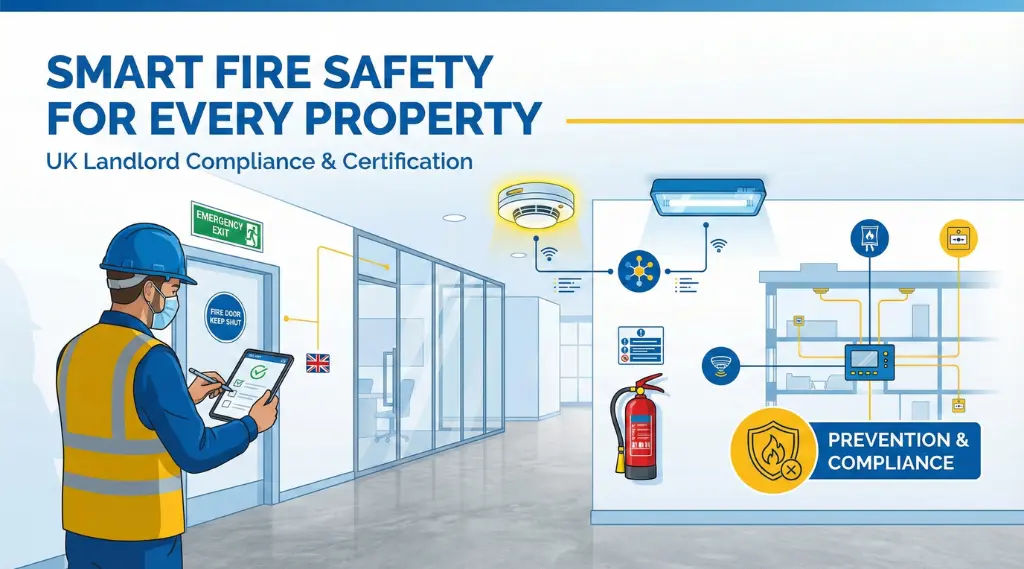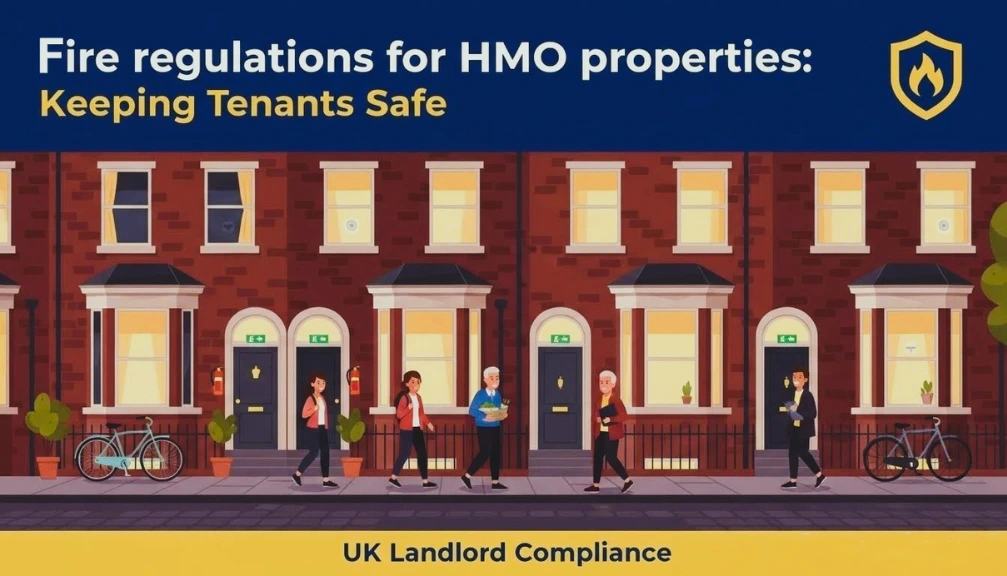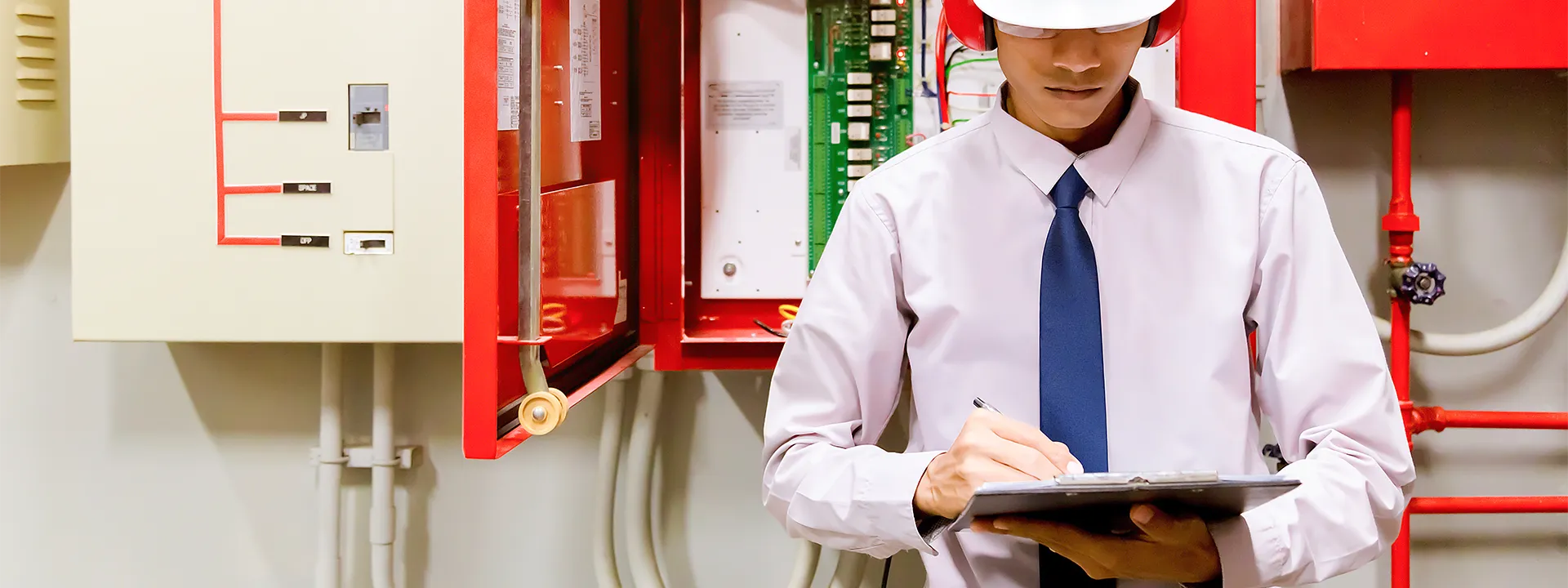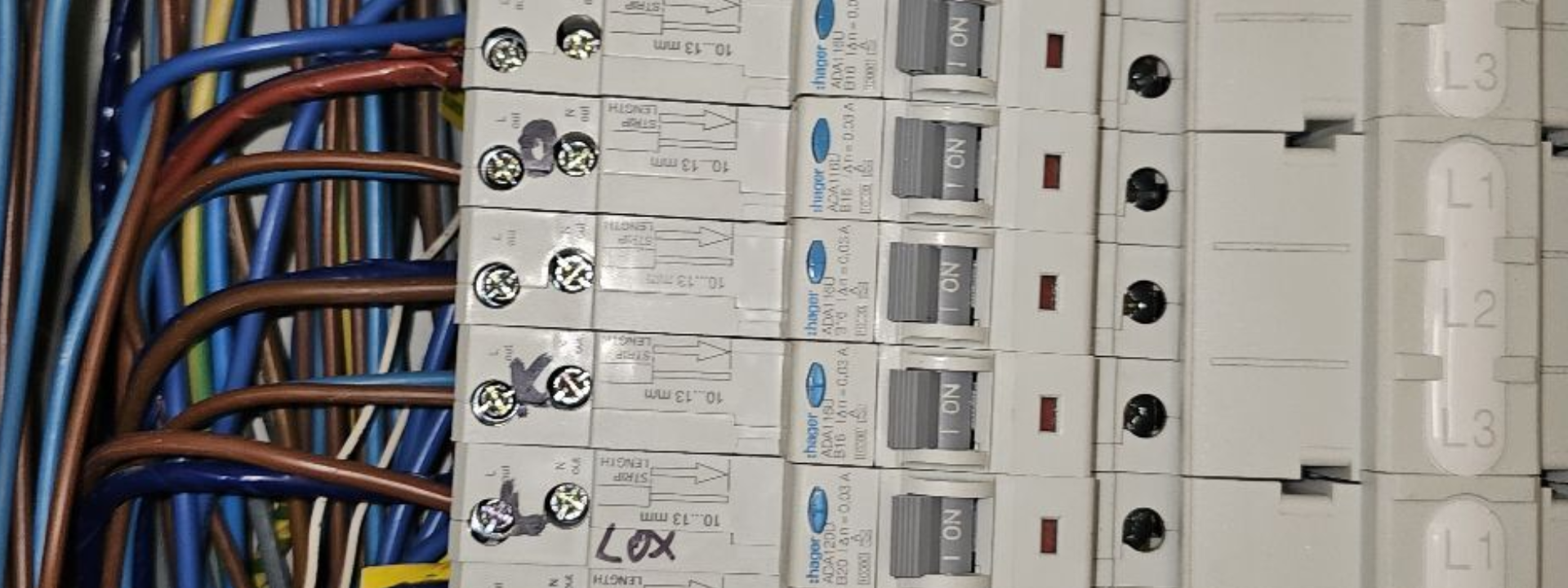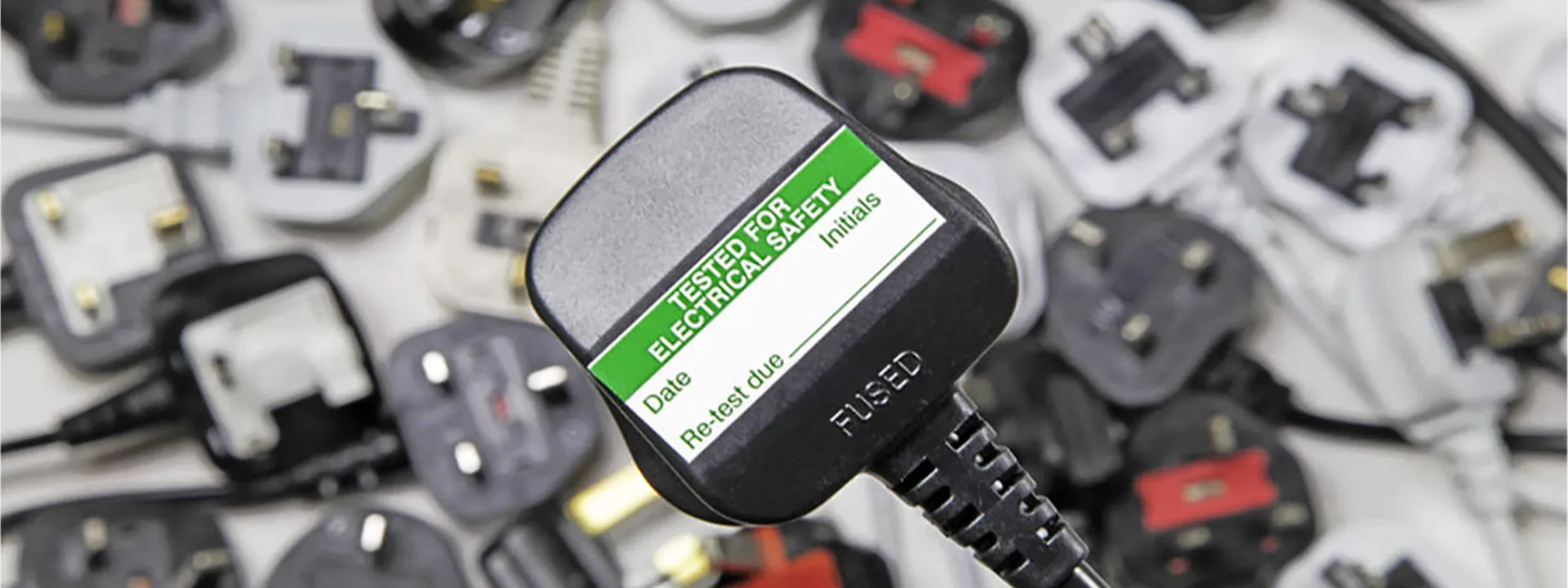Do you know how safe your property is from fire risks? As a landlord, you need to know about it. A building with clear fire safety checks can cut the chance of a fire by over 60%. Knowing the types of fire risk assessment gives you a simple way to spot risks and take steps that keep everyone safe.
Many properties have hidden issues. About 40% show problems with fire doors or alarms, and nearly 30% have blocked or confusing escape routes. A proper fire risk assessment shows these issues, keeps you following the rules, and protects your tenants and visitors.
In this blog, we talk about how fire risk assessments work, the different types of fire risk assessment UK, and the standards that make your property safe. Let’s dive into this.
What is a Fire Risk Assessment and Why is it Required?
A fire risk assessment checks your property for fire dangers and looks at how people can escape safely. It is required to keep people safe, spot fire risks, and make sure the building follows the rules. It also helps landlords protect tenants, visitors, and the property.
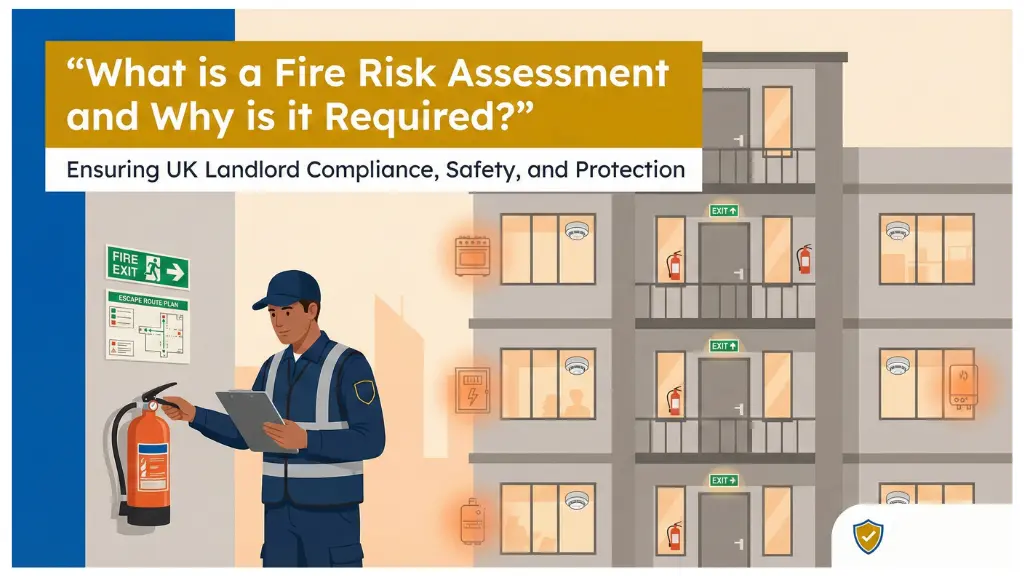
Understanding Fire Safety Regulations UK Requirements
Fire safety regulations in the UK are designed to protect lives and property. These rules also ensure that buildings meet minimum safety standards. Landlords, take a look at key aspects of fire safety regulations in the UK:
![]() Fire Risk Assessments: Property owners must identify fire hazards, evaluate risks, and implement preventive measures.
Fire Risk Assessments: Property owners must identify fire hazards, evaluate risks, and implement preventive measures.![]() Means of Escape: Buildings must have clearly marked, accessible escape routes for all occupants.
Means of Escape: Buildings must have clearly marked, accessible escape routes for all occupants.![]() Fire Detection and Alarm Systems: Effective systems must be installed and maintained to warn occupants of a fire.
Fire Detection and Alarm Systems: Effective systems must be installed and maintained to warn occupants of a fire.![]() Firefighting Equipment: Adequate extinguishers and other firefighting tools must be available and maintained.
Firefighting Equipment: Adequate extinguishers and other firefighting tools must be available and maintained.![]() Staff Training and Fire Procedures: Occupants or employees must be trained in fire safety and evacuation procedures.
Staff Training and Fire Procedures: Occupants or employees must be trained in fire safety and evacuation procedures.
Legal Requirements & Regulatory Compliance
If you own or manage a property in the UK, following fire safety rules keeps everyone safe and keeps your property legal. Here’s what you need to know:
Follow the Law![]() Comply with the Regulatory Reform (Fire Safety) Order 2005.
Comply with the Regulatory Reform (Fire Safety) Order 2005.![]() Residential landlords follow the Housing Act 2004 and the Housing Health and Safety Rating System (HHSRS).
Residential landlords follow the Housing Act 2004 and the Housing Health and Safety Rating System (HHSRS).![]() Install smoke alarms on every floor and carbon monoxide alarms in rooms with fuel appliances.
Install smoke alarms on every floor and carbon monoxide alarms in rooms with fuel appliances.
![]() Smoke and Carbon Monoxide Alarms: Put smoke alarms on every floor and carbon monoxide alarms in rooms with fuel appliances.
Smoke and Carbon Monoxide Alarms: Put smoke alarms on every floor and carbon monoxide alarms in rooms with fuel appliances.![]() Fire Risk Assessment: Look for fire hazards in the property, think about how they affect people, plan ways to lower risks, and write down what you find.
Fire Risk Assessment: Look for fire hazards in the property, think about how they affect people, plan ways to lower risks, and write down what you find.![]() Fire Safety Measures: Keep escape routes open and easy to use, make sure alarms work, keep fire extinguishers in place, and use signs and lights to guide people safely.
Fire Safety Measures: Keep escape routes open and easy to use, make sure alarms work, keep fire extinguishers in place, and use signs and lights to guide people safely.![]() Training and Instructions: Show everyone what to do if a fire starts and give clear, simple safety instructions.
Training and Instructions: Show everyone what to do if a fire starts and give clear, simple safety instructions.![]() Maintenance and Records: Check all fire safety equipment regularly and keep notes of checks, training, and risk assessments.
Maintenance and Records: Check all fire safety equipment regularly and keep notes of checks, training, and risk assessments.![]() Why Compliance Matters: Following the rules keeps people safe, prevents trouble, protects insurance, and shows that safety matters.
Why Compliance Matters: Following the rules keeps people safe, prevents trouble, protects insurance, and shows that safety matters.
When is a Fire Risk Assessment Required for Your Property?
Fire risk assessment requirements apply to almost every property in the UK. They help keep people safe and make sure your property follows the law.
Here’s when an assessment is needed:![]() Build a New Property: A new building needs a fire risk assessment to make sure it is safe for everyone inside.
Build a New Property: A new building needs a fire risk assessment to make sure it is safe for everyone inside.![]() Change the Use of a Building: If a home becomes a rental or shared house, the property requires a check for fire hazards.
Change the Use of a Building: If a home becomes a rental or shared house, the property requires a check for fire hazards.![]() Major Renovations or Extensions: Adding rooms or changing the layout of a property calls for a fire safety review.
Major Renovations or Extensions: Adding rooms or changing the layout of a property calls for a fire safety review.![]() Change Escape Routes: Doors, hallways, and exits must stay clear, so any changes require a new assessment.
Change Escape Routes: Doors, hallways, and exits must stay clear, so any changes require a new assessment.![]() Regular Safety Checks: Fire risks appear as people use the property, so the assessment stays up-to-date.
Regular Safety Checks: Fire risks appear as people use the property, so the assessment stays up-to-date.![]() Shared or Multi-Occupancy Properties: Apartments, HMOs, and homes with shared spaces need assessments for common areas and to make sure everyone knows the escape routes.
Shared or Multi-Occupancy Properties: Apartments, HMOs, and homes with shared spaces need assessments for common areas and to make sure everyone knows the escape routes.![]() High-Risk Areas: Kitchens, boiler rooms, and areas with electrical equipment require extra attention to reduce the risk of fire.
High-Risk Areas: Kitchens, boiler rooms, and areas with electrical equipment require extra attention to reduce the risk of fire.
Why is a Fire Risk Assessment Carried Out by Property Owners?
When it comes to keeping your property safe, fire risk assessments are a must for owners. They help spot dangers and make sure everyone inside stays safe.
Here’s why property owners carry them out:![]() Make sure residents and visitors stay safe.
Make sure residents and visitors stay safe.![]() Identify things that can start a fire or make it spread.
Identify things that can start a fire or make it spread.![]() Check that doors, hallways, and exits stay clear and easy to use.
Check that doors, hallways, and exits stay clear and easy to use.![]() Add alarms, fire extinguishers, and exit signs were required.
Add alarms, fire extinguishers, and exit signs were required.![]() Follow UK fire safety rules and avoid fines or legal issues.
Follow UK fire safety rules and avoid fines or legal issues.![]() Keep insurance valid by maintaining safety standards.
Keep insurance valid by maintaining safety standards.![]() Attract tenants and give people confidence in the property.
Attract tenants and give people confidence in the property.![]() Reduce the risk of serious damage or danger in the future.
Reduce the risk of serious damage or danger in the future.
What Are the Different Types of Fire Risk Assessments?
Landlords, this part is essential for you. The types of fire risk assessments help you understand the level of checking your building needs. These fire risk assessment types link to UK rules like the Fire Safety Order 2005 and the Fire Safety Act 2021.

Type 1 Fire Risk Assessment: Non-Destructive Visual Inspection
A Type 1 fire risk assessment keeps things simple. It looks at shared areas and checks them with your eyes. What a Type 1 Assessment Includes:
![]() Checks of escape routes, fire doors and emergency lighting based on BS 5266.
Checks of escape routes, fire doors and emergency lighting based on BS 5266.![]() Review of fire signs under Regulation 8 of the Fire Safety Order.
Review of fire signs under Regulation 8 of the Fire Safety Order.![]() Look for clear breaks in compartmentation without breaking walls or ceilings.
Look for clear breaks in compartmentation without breaking walls or ceilings.![]() Confirm that people move out of the building in a safe and quick way.
Confirm that people move out of the building in a safe and quick way.
Type 2 Fire Risk Assessment: Destructive Investigation Methods
A Type 2 assessment takes you inside the building and shows you fire risks hiding in different areas.
What a Type 2 Assessment Includes:![]() Opening small parts of walls, ceilings, or risers to see fire stopping and compartmentation.
Opening small parts of walls, ceilings, or risers to see fire stopping and compartmentation.![]() Checks based on Approved Document B for structure and layout.
Checks based on Approved Document B for structure and layout.![]() Review of hidden voids linked to the Fire Safety Act 2021.
Review of hidden voids linked to the Fire Safety Act 2021.![]() Work is done by trained teams who follow Regulation 38 rules for safe building information.
Work is done by trained teams who follow Regulation 38 rules for safe building information.
A fire safety risk assessment for a block of flats helps spot hazards and protect residents. The right type of assessment checks alarms, escape routes, and exits. A proper fire risk assessment involves looking at fire doors, risks to life, and dangers in the event of a fire. Following the risk assessment process creates an effective fire plan and guidance from the local fire authority.
Type 3 Fire Risk Assessment: Comprehensive Structural Survey
A Type 3 assessment lets you look inside flats and spot fire risks without causing any damage.
What a Type 3 Assessment Includes:![]() Checks of smoke alarms inside homes based on BS 5839-6.
Checks of smoke alarms inside homes based on BS 5839-6.![]() Review of flat escape routes set out in the Fire Safety England Regulations 2022.
Review of flat escape routes set out in the Fire Safety England Regulations 2022.![]() Look at flat entrance doors to confirm the FD30S standard.
Look at flat entrance doors to confirm the FD30S standard.![]() Check the plan for stay-put or full evacuation for residents.
Check the plan for stay-put or full evacuation for residents.
Type 4 Fire Risk Assessment: Full Building Evaluation
A Type 4 assessment is the deepest level. It opens areas across shared spaces and inside flats.
What a Type 4 Assessment Includes:![]() Opening parts of the building to confirm the strong compartmentation set out in Approved Document B.
Opening parts of the building to confirm the strong compartmentation set out in Approved Document B.![]() Checks of ducts, cable holes, and other service routes.
Checks of ducts, cable holes, and other service routes.![]() Review of passive fire protection linked to BS 9999.
Review of passive fire protection linked to BS 9999.![]() Good for high-risk buildings or places with clear safety concerns.
Good for high-risk buildings or places with clear safety concerns.
The four types of fire risk focus on fire resistance of doors, potential hazards, and how to ensure the safety of everyone inside. Property owners conduct fire risk checks because it is required under the fire safety rules to find fire risks within a building.
Comparison Table: Type 1-4 Assessment Differences
Levels of fire risk assessment look at different parts of a building and help you find problems before they grow. Each type checks differently and gives you a clear picture of risks. Here is a simple guide to Type 1 to Type 4 assessments:
Assessm-ent Type
What It Covers
How It Works
Level of Detail
Your Role
Type 1
Shared areas
Visual checks in plain sight
Simple
You spot main risks easily
Type 2
Shared areas and inside parts of the building
Opens areas to find hidden risks
Moderate
You explore more areas and notice hidden risks
Type 3
Flats and apart-ments
Checks inside without causing damage
Detailed
You look inside flats and see risks safely
Type 4
Indivi-dual units or full building
Full check, including all areas
Very detailed
You investigate every corner to find all risks
How Do Fire Risk Assessment Standards Compare: PAS 79 vs BS 9792:2025?
When you check fire safety in a building, knowing the right standards helps. PAS 79 and BS 9792:2025 guide fire risk assessments in different ways. Each gives clear steps for checking safety, recording findings, and keeping people safe.
PAS 79 Fire Risk Assessment Framework and Guidelines
PAS 79 helps landlords and managers check safety in the right way for each type of building.
Take a look at these key points:![]() Record hazards, risks, and actions in a clear way.
Record hazards, risks, and actions in a clear way.![]() Focus on communal areas, escape routes, fire doors, and staircases.
Focus on communal areas, escape routes, fire doors, and staircases.![]() Help the Responsible Person meet duties under RRFSO 2005, Regulation 8.
Help the Responsible Person meet duties under RRFSO 2005, Regulation 8.![]() Guide checks of fire alarms, emergency lighting, signage, and call points.
Guide checks of fire alarms, emergency lighting, signage, and call points.![]() Show compliance with Fire Safety (England) Regulations 2022.
Show compliance with Fire Safety (England) Regulations 2022.![]() Include templates to make reports clear for managers, owners, and safety teams.
Include templates to make reports clear for managers, owners, and safety teams.![]() Prioritize the most serious risks and plan improvements.
Prioritize the most serious risks and plan improvements.![]() Encourage regular reviews to meet RRFSO 2005, Article 17.
Encourage regular reviews to meet RRFSO 2005, Article 17.![]() PAS 79-1:2020 focuses on commercial buildings and checks escape routes, alarms, and building safety systems.
PAS 79-1:2020 focuses on commercial buildings and checks escape routes, alarms, and building safety systems.![]() PAS 79-2:2020 focuses on housing, checking shared areas, flat entrances, and resident evacuation plans.
PAS 79-2:2020 focuses on housing, checking shared areas, flat entrances, and resident evacuation plans.
BS 9792:2025 Fire Risk Assessment Standards
BS 9792:2025 gives clear standards for carrying out fire risk assessments in buildings. This standard helps make sure the building stays safe and follows UK law.
The key points are:![]() Step-by-step guidance for inspecting all areas of a building.
Step-by-step guidance for inspecting all areas of a building.![]() Focus on structural fire safety, fire-stopping, and compartmentation.
Focus on structural fire safety, fire-stopping, and compartmentation.![]() Check fire doors, smoke detection, alarms, sprinklers, and escape routes.
Check fire doors, smoke detection, alarms, sprinklers, and escape routes.![]() Align inspections with Approved Document B, Building Regulations 2019.
Align inspections with Approved Document B, Building Regulations 2019.![]() Record findings clearly to meet the Fire Safety Act 2021 and RRFSO 2005, Article 9.
Record findings clearly to meet the Fire Safety Act 2021 and RRFSO 2005, Article 9.![]() Include checks of mechanical and electrical systems that affect fire safety.
Include checks of mechanical and electrical systems that affect fire safety.![]() Review resident evacuation plans under RRFSO 2005, Article 13.
Review resident evacuation plans under RRFSO 2005, Article 13.![]() Support larger buildings or complexes with multiple flats or commercial spaces.
Support larger buildings or complexes with multiple flats or commercial spaces.![]() Make it easy to show compliance to regulators and safety teams.
Make it easy to show compliance to regulators and safety teams.![]() Help create clear reports that guide action on hazards.
Help create clear reports that guide action on hazards.
Fire Risk Appraisal of External Walls (FRAEW): PAS 9980:2022
External walls play a big role in fire safety, especially in tall or multi-storey buildings. PAS 9980:2022 gives clear guidance to check these walls properly and reduce risks.
Important Details![]() Look at materials, cladding, insulation, and wall panels.
Look at materials, cladding, insulation, and wall panels.![]() Assess the chance of fire spreading on the outside of a building.
Assess the chance of fire spreading on the outside of a building.![]() Decide if repairs, replacements, or upgrades improve safety.
Decide if repairs, replacements, or upgrades improve safety.![]() Work together with PAS 79 and BS 9792:2025 to see the full picture of building safety.
Work together with PAS 79 and BS 9792:2025 to see the full picture of building safety.![]() Follow Building Regulations Approved Document B for legal compliance.
Follow Building Regulations Approved Document B for legal compliance.![]() Support responsibilities under the Fire Safety Act 2021 for external walls.
Support responsibilities under the Fire Safety Act 2021 for external walls.![]() Keep clear records for inspections and regulatory checks.
Keep clear records for inspections and regulatory checks.![]() Check gaps, joints, and penetrations that can let fire spread.
Check gaps, joints, and penetrations that can let fire spread.
Fire Risk Assessment Guidance for Compliance
Guide to fire risk assessment helps landlords and building managers keep residents safe and follow UK fire safety laws.
![]() Check fire alarms, emergency lighting, fire doors, and escape routes.
Check fire alarms, emergency lighting, fire doors, and escape routes.![]() Inspect shared areas, staircases, corridors, and entrances to flats.
Inspect shared areas, staircases, corridors, and entrances to flats.![]() Review external walls, cladding, insulation, and fire-stopping.
Review external walls, cladding, insulation, and fire-stopping.![]() Keep clear and simple records of hazards, risks, and actions.
Keep clear and simple records of hazards, risks, and actions.![]() Follow Regulatory Reform (Fire Safety) Order 2005, Fire Safety Act 2021, and Fire Safety (England) Regulations 2022.
Follow Regulatory Reform (Fire Safety) Order 2005, Fire Safety Act 2021, and Fire Safety (England) Regulations 2022.![]() Maintain reports for inspections and audits by fire safety teams or regulators.
Maintain reports for inspections and audits by fire safety teams or regulators.![]() Schedule regular checks and updates to maintain fire safety.
Schedule regular checks and updates to maintain fire safety.![]() Make sure residents understand evacuation routes and emergency procedures.
Make sure residents understand evacuation routes and emergency procedures.![]() Use PAS 79, BS 9792:2025, and PAS 9980:2022 together for a complete building safety assessment.
Use PAS 79, BS 9792:2025, and PAS 9980:2022 together for a complete building safety assessment.
Which Type of Fire Risk Assessment Do You Need for Your Property?

Determining the correct type of fire risk assessment for your property is crucial to ensure safety and compliance. Use this decision tree to identify which assessment applies to your situation.
Decision Tree: Determining Your Assessment Type
What type of property do you own or manage?![]() Residential Property (single-family homes, apartments) → Proceed to Residential Fire Risk Assessment.
Residential Property (single-family homes, apartments) → Proceed to Residential Fire Risk Assessment.![]() Commercial Property (offices, shops, warehouses) → Proceed to Commercial Property Fire Risk Assessment.
Commercial Property (offices, shops, warehouses) → Proceed to Commercial Property Fire Risk Assessment.![]() HMO Property (Houses in Multiple Occupation) → Proceed to Fire Risk Assessment for HMO Properties.
HMO Property (Houses in Multiple Occupation) → Proceed to Fire Risk Assessment for HMO Properties.
Do multiple households or tenants occupy the building?![]() Yes → HMO assessment required.
Yes → HMO assessment required.![]() No → Standard residential or commercial assessment based on use.
No → Standard residential or commercial assessment based on use.
Residential Fire Risk Assessment Requirements
A residential fire risk assessment is designed for single-family homes, flats, or apartment buildings.
Key considerations include:![]() Identification of fire hazards (electrical, cooking, heating equipment)
Identification of fire hazards (electrical, cooking, heating equipment)![]() Fire detection and warning systems
Fire detection and warning systems![]() Means of escape in case of fire
Means of escape in case of fire![]() Emergency procedures and resident awareness
Emergency procedures and resident awareness![]() Regular review and maintenance
Regular review and maintenance
Commercial Property Fire Risk Assessment Specifications
A commercial property fire risk assessment is essential for offices, shops, industrial units, and other non-residential buildings. Key considerations include:
![]() Risk identification for employees, customers, and visitors.
Risk identification for employees, customers, and visitors.![]() Fire detection, alarm, and suppression systems.
Fire detection, alarm, and suppression systems.![]() Emergency routes and evacuation plans.
Emergency routes and evacuation plans.![]() Staff training and drills.
Staff training and drills.![]() Legal compliance under workplace fire safety regulations.
Legal compliance under workplace fire safety regulations.
Fire Risk Assessment for HMO Properties
Houses in Multiple Occupation (HMOs) require a specialized fire risk assessment for HMO properties, due to multiple unrelated tenants living in the same building.
Key considerations include:![]() Fire doors and compartmentation between units.
Fire doors and compartmentation between units.![]() Fire detection systems in common areas and individual units.
Fire detection systems in common areas and individual units.![]() Emergency escape routes for all tenants.
Emergency escape routes for all tenants.![]() Tenant education on fire safety.
Tenant education on fire safety.![]() Compliance with HMO licensing and fire safety standards.
Compliance with HMO licensing and fire safety standards.
What Does a Fire Risk Assessment Checklist Include?
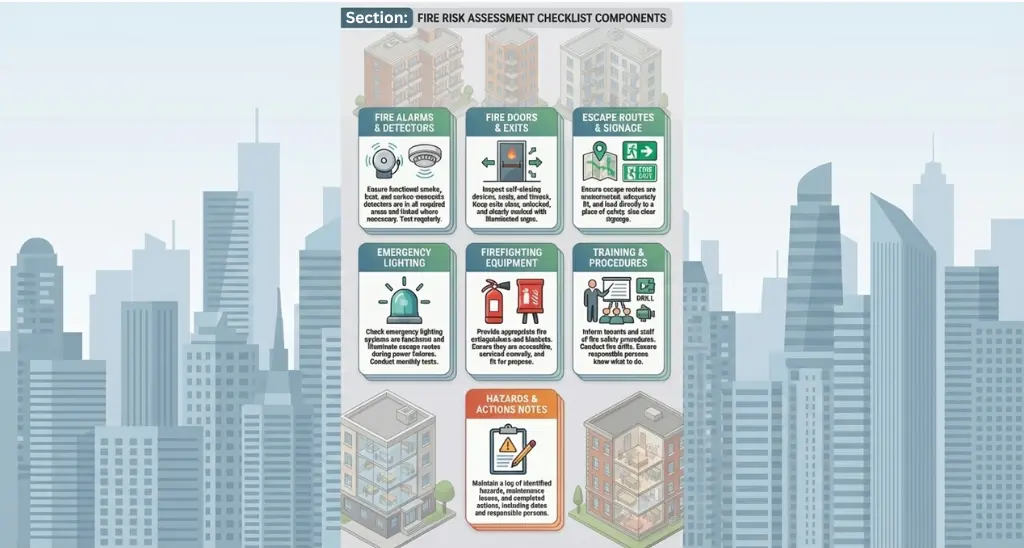
A fire risk assessment checklist helps you keep your property and everyone in it safe. It shows what to check and the steps to take to reduce fire risks.
Essential Risk Assessment Steps to Follow
Steps in fire risk assessment show how to keep your property and everyone inside safe. Landlords, here we give a clear assessment. Check it:
![]() Identify fire hazards: Check sources of heat, fuel, and materials that can catch fire.
Identify fire hazards: Check sources of heat, fuel, and materials that can catch fire.![]() Who is at risk: Look at residents, staff, visitors, and anyone else who may be in the building.
Who is at risk: Look at residents, staff, visitors, and anyone else who may be in the building.![]() Evaluate the risk: Decide how serious the risk is and how easy it is for people to escape.
Evaluate the risk: Decide how serious the risk is and how easy it is for people to escape.![]() Record findings: Write down what you find and what you plan to fix.
Record findings: Write down what you find and what you plan to fix.![]() Act on recommendations: Fix problems and make the property safer.
Act on recommendations: Fix problems and make the property safer.![]() Review regularly: Check the property often to keep safety up-to-date.
Review regularly: Check the property often to keep safety up-to-date.
What is Fire Risk Assessment Checklist Components?
Fire safety for landlords starts with a simple checklist that makes the assessment easy to follow.
Here we give you a component’s checklist:![]() Fire alarms, smoke detectors, and alert systems.
Fire alarms, smoke detectors, and alert systems.![]() Fire doors and emergency exits.
Fire doors and emergency exits.![]() Escape routes and signage.
Escape routes and signage.![]() Emergency lighting.
Emergency lighting.![]() Firefighting equipment, like extinguishers.
Firefighting equipment, like extinguishers.![]() Training and safety procedures for occupants.
Training and safety procedures for occupants.![]() Notes on hazards and actions taken.
Notes on hazards and actions taken.
How Long Do Fire Risk Assessments Last?
Let’s talk about fire risk assessments and how long they stay useful. Buildings change, people move in and out, and new risks can appear, so an assessment cannot stay the same forever.
Landlords check the assessment at least once every year. If a new room goes in, the layout changes, or there are big updates, it needs another look right away.
If a fire happens or there is a close call, it is important to review the assessment again. Regular checks help catch problems early and keep tenants safe.
How to Choose Professional Fire Risk Assessment Services?
When you choose fire risk assessment services, find experts who know your building and explain things clearly. Check their certifications, ask for references, and ensure they follow current standards. This way, you keep everyone and everything safe.
Comparing Fire Risk Assessment Companies
Finding a fire risk assessment company does not have to be confusing. Check what each company does and how they talk to landlords. A company that explains things clearly makes everything easier.
Look at their experience and the types of buildings they check. Companies that know houses, flats, or shared homes give a more useful assessment.
Alllandlordcertificates.co.uk is a company that works directly with landlords. We also offer clear fire risk assessments for houses, flats, and shared homes. Our goal is to make the process simple and easy to understand so landlords know exactly what needs checking and what actions to take.
Assessor Credentials and Competence Requirements
London fire risk assessment companies provide expert services to keep your building and people safe. When you choose fire risk assessment companies, it is important to check assessor credentials and competence. Look for qualifications like NEBOSH, TRUSTMARK, NICEIC, Fire Risk Assessor Certification, NAPIT, City & Guilds Fire Safety, and Institution of Fire Engineers (IFE). These certifications show assessors have the right training and knowledge to identify risks and keep your building safe. We also have these credentials and competence services available at All Landlord Certificates.
What Fire Risk Assessment Services Should Include
Fire risk assessment services cover more than a checklist. They check the property carefully to make sure everyone inside stays safe. The trusted and experienced company, like alllandlordcertificates.co.uk, provides these services.
That is why a proper fire risk assessment includes:![]() Spotting fire hazards around the property
Spotting fire hazards around the property![]() Looking at risks for tenants, staff, and visitors
Looking at risks for tenants, staff, and visitors![]() Checking smoke alarms, fire extinguishers, and escape routes
Checking smoke alarms, fire extinguishers, and escape routes![]() Giving clear advice on how to fix any problems
Giving clear advice on how to fix any problems![]() Creating a simple report that landlords can follow easily
Creating a simple report that landlords can follow easily
Fire Risk Assessment Cost Guide
Fire risk assessment costs depend on the property and how much work the assessor needs to do. For landlords, it helps to know what to expect, so there are no surprises. Here is a table that shows common costs for different properties:
Property Type
Cost Range
Single-family home or flat
£80 - £150
Small HMO (2-5 tenants)
£120 - £250
Large HMO (6+ tenants)
£200 - £400
Small commercial property
£150 - £300
Large commercial property
£300 - £600+
Cost Considerations for Different Types of Fire Risk Assessments
Fire risk assessment costs change depending on the property and the work needed. For landlords, understanding the differences makes planning easier and avoids surprises.
Residential properties: Houses and flats cost less because there is only one household and fewer areas to check.
Small HMOs (2-5 tenants): Costs rise because each room and shared space requires a careful check, along with escape routes.
Large HMOs (6+ tenants): Bigger buildings take more time and more detailed checks, so the price goes up.
Small commercial properties: Offices, shops, or small workplaces are quicker to assess, keeping costs lower.
Large commercial properties: Warehouses, factories, and multi-floor buildings require extra checks, so the cost is higher.
Other factors: The number of floors, building age, fire doors, alarms, and sprinklers can affect the price.
Investing in a proper assessment helps landlords keep tenants safe and avoid bigger problems later.
Case Study
Title: Hind Hotel Wellingborough Fire Case and Public Safety Impact
In Wellingborough, a hotel fails to keep its fire alarm system fully working. Inspectors find safety gaps, and the building does not have a proper fire risk assessment in place. Key lessons and safety impacts:
![]() Fire alarms must work across all areas to warn people in time.
Fire alarms must work across all areas to warn people in time.![]() Fire risk assessments must be carried out and updated regularly.
Fire risk assessments must be carried out and updated regularly.![]() Owners and managers must fix safety problems promptly.
Owners and managers must fix safety problems promptly.
Fines and legal action: The hotel is fined £75,000, pays £4,200 in costs, and a £2,000 victim surcharge for breaking the Regulatory Reform (Fire Safety) Order 2005.
This case shows the importance of a proper fire risk assessment for protecting people and staying compliant with UK fire safety law.
Source: Northamptonshire Fire and Rescue Service – Wellingborough hotel fined £75k for fire safety failures.
Wrap up
It’s time to wrap up. Fire safety keeps people and buildings safe. A good fire risk assessment checks alarms, doors, escape routes, and any risks you might miss. Doing these checks protects everyone and keeps your property legal. Regular checks give peace of mind and make life easier for tenants. Taking action now shows you care about their safety. Head over to alllandlordcertificates.co.uk to book an assessment and keep your building safe.
